Share what you know,
and discover more.
Share what you know,
and discover more.
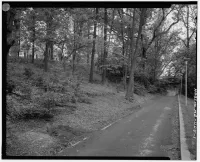
-

- Marley Zielike
Wilson Estate, 9100 Rockville Pike, Bethesda, Montgomery County, MD
The Wilson Estate derives historical significance from the role played by the Wilson family in attracting the National Institutes of Health (NIH) to Bethesda through their initial donation of land, and from the continuing growth of NIH into its suburban campus setting. Luke and Helen Wilson`s donations of land to the federal government enabled the National Institute of Health, which had been crowded into buildings at 25th and E Streets, N.W., the opportunity to expand. As the scope of the institution`s mission grew, so too did the physical plant; work at NIH soon covered the entire spectrum of research on human disease and encompassed several distinct institutes. This rapid and orchestrated growth dramatically changed the face of Bethesda. Today NIH is the most dominant institutional presence in Montgomery County. The Wilson`s gift of land to the federal government augured this physical transformation of the local community. On a national level, the bequest enabled the growth of the institution into one of the world`s preeminent medical research facilities. This collection of buildings within its landscape is also significant as one of the architecturally distinguished Rockville Pike estates of the early twentieth century, representing an important phase in the development of Montgomery County. The Wilson Estate, or Tree Tops, as it was known, was part of a corridor of large, early twentieth-century country estates built by wealthy Washingtonians along Rockville Pike. The Wilson Estate evolved at the height of an era of great country houses in Montgomery County. The Wilson Estate was distinct from many of these other country houses, however, in its rustic English style; most of the grand houses along the Pike reflected the colonial history of the country and were designed in a corresponding Georgian Revival style, such as the neighboring George Freeland Peter Estate (Building 16 on the NIH campus).
Wilson Estate, 9100 Rockville Pike, Bethesda, Montgomery County, MD
The Wilson Estate derives historical significance from the role played by the Wilson family in attracting the National Institutes of Health (NIH) to Bethesda through their initial donation of land, and from the continuing growth of NIH into its suburban campus setting. Luke and Helen Wilson`s donations of land to the federal government enabled the National Institute of Health, which had been crowded into buildings at 25th and E Streets, N.W., the opportunity to expand. As the scope of the institution`s mission grew, so too did the physical plant; work at NIH soon covered the entire spectrum of research on human disease and encompassed several distinct institutes. This rapid and orchestrated growth dramatically changed the face of Bethesda. Today NIH is the most dominant institutional presence in Montgomery County. The Wilson`s gift of land to the federal government augured this physical transformation of the local community. On a national level, the bequest enabled the growth of the institution into one of the world`s preeminent medical research facilities. This collection of buildings within its landscape is also significant as one of the architecturally distinguished Rockville Pike estates of the early twentieth century, representing an important phase in the development of Montgomery County. The Wilson Estate, or Tree Tops, as it was known, was part of a corridor of large, early twentieth-century country estates built by wealthy Washingtonians along Rockville Pike. The Wilson Estate evolved at the height of an era of great country houses in Montgomery County. The Wilson Estate was distinct from many of these other country houses, however, in its rustic English style; most of the grand houses along the Pike reflected the colonial history of the country and were designed in a corresponding Georgian Revival style, such as the neighboring George Freeland Peter Estate (Building 16 on the NIH campus).
Wilson Estate, 9100 Rockville Pike, Bethesda, Montgomery County, MD
The Wilson Estate derives historical significance from the role played by the Wilson family in attracting the National Institutes of Health (NIH) to Bethesda through their initial donation of land, and from the continuing growth of NIH into its suburban campus setting. Luke and Helen Wilson`s donations of land to the federal government enabled the National Institute of Health, which had been crowded into buildings at 25th and E Streets, N.W., the opportunity to expand. As the scope of the institution`s mission grew, so too did the physical plant; work at NIH soon covered the entire spectrum of research on human disease and encompassed several distinct institutes. This rapid and orchestrated growth dramatically changed the face of Bethesda. Today NIH is the most dominant institutional presence in Montgomery County. The Wilson`s gift of land to the federal government augured this physical transformation of the local community. On a national level, the bequest enabled the growth of the institution into one of the world`s preeminent medical research facilities. This collection of buildings within its landscape is also significant as one of the architecturally distinguished Rockville Pike estates of the early twentieth century, representing an important phase in the development of Montgomery County. The Wilson Estate, or Tree Tops, as it was known, was part of a corridor of large, early twentieth-century country estates built by wealthy Washingtonians along Rockville Pike. The Wilson Estate evolved at the height of an era of great country houses in Montgomery County. The Wilson Estate was distinct from many of these other country houses, however, in its rustic English style; most of the grand houses along the Pike reflected the colonial history of the country and were designed in a corresponding Georgian Revival style, such as the neighboring George Freeland Peter Estate (Building 16 on the NIH campus).Posted Date
Sep 28, 2021
Source Name
Library of Congress
Source Website
Delete Story
Are you sure you want to delete this story?
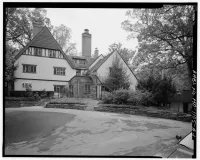
-

- Marley Zielike
Wilson Estate, Tree Tops, 9100 Rockville Pike, Bethesda, Montgomery County, MD
Constructed in 1926 to the design of architect Edward Clarence Dean, Tree Tops served until 1942 as the main residence for Luke I. and Helen W. Wilson and the focal point of a large estate that included several cottages and outbuildings. Tree Tops was the name originally given to the entire estate, but has come to be associated specifically with the main house over time. Building 15K is the name NIH has applied to the building. Tree Tops was one of several large estates that once lined Rockville Pike, and as such it is important for the role it played in the establishment of the National Institutes of Health in Bethesda, as the Wilson donated numerous acres over a period of time from 1935 to 1993, including Tree Tops itself in 1942.
Wilson Estate, Tree Tops, 9100 Rockville Pike, Bethesda, Montgomery County, MD
Constructed in 1926 to the design of architect Edward Clarence Dean, Tree Tops served until 1942 as the main residence for Luke I. and Helen W. Wilson and the focal point of a large estate that included several cottages and outbuildings. Tree Tops was the name originally given to the entire estate, but has come to be associated specifically with the main house over time. Building 15K is the name NIH has applied to the building. Tree Tops was one of several large estates that once lined Rockville Pike, and as such it is important for the role it played in the establishment of the National Institutes of Health in Bethesda, as the Wilson donated numerous acres over a period of time from 1935 to 1993, including Tree Tops itself in 1942.
Wilson Estate, Tree Tops, 9100 Rockville Pike, Bethesda, Montgomery County, MD
Constructed in 1926 to the design of architect Edward Clarence Dean, Tree Tops served until 1942 as the main residence for Luke I. and Helen W. Wilson and the focal point of a large estate that included several cottages and outbuildings. Tree Tops was the name originally given to the entire estate, but has come to be associated specifically with the main house over time. Building 15K is the name NIH has applied to the building. Tree Tops was one of several large estates that once lined Rockville Pike, and as such it is important for the role it played in the establishment of the National Institutes of Health in Bethesda, as the Wilson donated numerous acres over a period of time from 1935 to 1993, including Tree Tops itself in 1942.Posted Date
Sep 28, 2021
Source Name
Library of Congress
Source Website
Delete Story
Are you sure you want to delete this story?
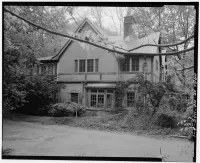
-

- Marley Zielike
Wilson Estate, The Lodge, 9100 Rockville Pike, Bethesda, Montgomery County, MD
The Lodge was one of the principal buildings comprising the original Wilson estate. Following the donation of Tree Tops to NIH in 1942, the Lodge served as the primary residence for two generations of the Wilson family. Attributed to architect Edward Clarence Dean, it was constructed utilizing a portion of a pre-existing farmhouse on the site that dated from the nineteenth century. Its architectural detailing closely resembles Tree Tops, suggesting that it was designed as part of an ensemble. In the 1960s, the Lodge was expanded substantially with two additions to accommodate Luke W. Wilson, the son, and his family, after the death of his mother Helen in 1960. The house remained in the Wilson family until 1993, at which time it was sold to NIH. The Lodge is significant as one of the key buildings of the original estate designed by architect Clarence Dean, and also as the primary residence of the Wilson family - the donors responsible for the establishment of NIH in its suburban Bethesday campus.
Wilson Estate, The Lodge, 9100 Rockville Pike, Bethesda, Montgomery County, MD
The Lodge was one of the principal buildings comprising the original Wilson estate. Following the donation of Tree Tops to NIH in 1942, the Lodge served as the primary residence for two generations of the Wilson family. Attributed to architect Edward Clarence Dean, it was constructed utilizing a portion of a pre-existing farmhouse on the site that dated from the nineteenth century. Its architectural detailing closely resembles Tree Tops, suggesting that it was designed as part of an ensemble. In the 1960s, the Lodge was expanded substantially with two additions to accommodate Luke W. Wilson, the son, and his family, after the death of his mother Helen in 1960. The house remained in the Wilson family until 1993, at which time it was sold to NIH. The Lodge is significant as one of the key buildings of the original estate designed by architect Clarence Dean, and also as the primary residence of the Wilson family - the donors responsible for the establishment of NIH in its suburban Bethesday campus.
Wilson Estate, The Lodge, 9100 Rockville Pike, Bethesda, Montgomery County, MD
The Lodge was one of the principal buildings comprising the original Wilson estate. Following the donation of Tree Tops to NIH in 1942, the Lodge served as the primary residence for two generations of the Wilson family. Attributed to architect Edward Clarence Dean, it was constructed utilizing a portion of a pre-existing farmhouse on the site that dated from the nineteenth century. Its architectural detailing closely resembles Tree Tops, suggesting that it was designed as part of an ensemble. In the 1960s, the Lodge was expanded substantially with two additions to accommodate Luke W. Wilson, the son, and his family, after the death of his mother Helen in 1960. The house remained in the Wilson family until 1993, at which time it was sold to NIH. The Lodge is significant as one of the key buildings of the original estate designed by architect Clarence Dean, and also as the primary residence of the Wilson family - the donors responsible for the establishment of NIH in its suburban Bethesday campus.Posted Date
Sep 28, 2021
Source Name
Library of Congress
Source Website
Delete Story
Are you sure you want to delete this story?
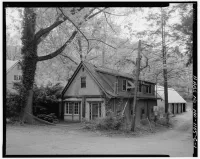
-

- Marley Zielike
Wilson Estate, The Flat, 9100 Rockville Pike, Bethesda, Montgomery County, MD
Originally constructed ca. 1926 as a one-story garage possibly with small staff quarters, "the Flat," as it was called by the Wilson family, was later expanded and converted into a guest house and servants quarters around the time of the Wilsons` 1942 donation of the principal residence, Tree Tops, to NIH. The Flat contains key architectural characteristics found on the Lodge and Tree Tops, and is considered an important element in a collection of building comprising the Wilson estate.
Wilson Estate, The Flat, 9100 Rockville Pike, Bethesda, Montgomery County, MD
Originally constructed ca. 1926 as a one-story garage possibly with small staff quarters, "the Flat," as it was called by the Wilson family, was later expanded and converted into a guest house and servants quarters around the time of the Wilsons` 1942 donation of the principal residence, Tree Tops, to NIH. The Flat contains key architectural characteristics found on the Lodge and Tree Tops, and is considered an important element in a collection of building comprising the Wilson estate.
Wilson Estate, The Flat, 9100 Rockville Pike, Bethesda, Montgomery County, MD
Originally constructed ca. 1926 as a one-story garage possibly with small staff quarters, "the Flat," as it was called by the Wilson family, was later expanded and converted into a guest house and servants quarters around the time of the Wilsons` 1942 donation of the principal residence, Tree Tops, to NIH. The Flat contains key architectural characteristics found on the Lodge and Tree Tops, and is considered an important element in a collection of building comprising the Wilson estate.Posted Date
Sep 28, 2021
Source Name
Library of Congress
Source Website
Delete Story
Are you sure you want to delete this story?
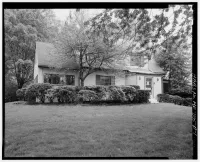
-

- Marley Zielike
Wilson Estate, Building No. 15A, 9100 Rockville Pike, Bethesda, Montgomery County, MD
This small residence was originally a neighboring house, dating from the 1920s, owned by Henriette Laura McCormack-Goodhurt. It was purchased by Helen W. Wilson in 1930 for use as a guest house by friends and family visiting the Wilson estate. Following her husband`s death, she donated the house along with 14.43 acres to the NIH in May of 1938. NIH, which labeled the building 15A, used the house as the living quarters before eventually adapting it for use as office space. Building 15A, used only a short time as a secondary building to the Wilson estate, was a significant portion of the 1938 donation to NIH dedicated to the development of the Cancer Institute.
Wilson Estate, Building No. 15A, 9100 Rockville Pike, Bethesda, Montgomery County, MD
This small residence was originally a neighboring house, dating from the 1920s, owned by Henriette Laura McCormack-Goodhurt. It was purchased by Helen W. Wilson in 1930 for use as a guest house by friends and family visiting the Wilson estate. Following her husband`s death, she donated the house along with 14.43 acres to the NIH in May of 1938. NIH, which labeled the building 15A, used the house as the living quarters before eventually adapting it for use as office space. Building 15A, used only a short time as a secondary building to the Wilson estate, was a significant portion of the 1938 donation to NIH dedicated to the development of the Cancer Institute.
Wilson Estate, Building No. 15A, 9100 Rockville Pike, Bethesda, Montgomery County, MD
This small residence was originally a neighboring house, dating from the 1920s, owned by Henriette Laura McCormack-Goodhurt. It was purchased by Helen W. Wilson in 1930 for use as a guest house by friends and family visiting the Wilson estate. Following her husband`s death, she donated the house along with 14.43 acres to the NIH in May of 1938. NIH, which labeled the building 15A, used the house as the living quarters before eventually adapting it for use as office space. Building 15A, used only a short time as a secondary building to the Wilson estate, was a significant portion of the 1938 donation to NIH dedicated to the development of the Cancer Institute.Posted Date
Sep 28, 2021
Source Name
Library of Congress
Source Website
Delete Story
Are you sure you want to delete this story?
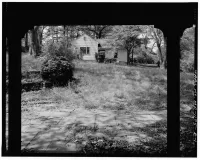
-

- Marley Zielike
Wilson Estate, The Cabin, 9100 Rockville Pike, Bethesda, Montgomery County, MD
The Cabin was one of a collection of buildings that comprised the Wilson Estate, Tree Tops. Associated perhaps with an earlier farm on the site, the building has an original main block that appears to date from the late nineteenth century. The Wilsons apparently moved the house to its current location at the southwestern corner of the estate, and enlarged it with a series of small additions for use as a guest cottage.
Wilson Estate, The Cabin, 9100 Rockville Pike, Bethesda, Montgomery County, MD
The Cabin was one of a collection of buildings that comprised the Wilson Estate, Tree Tops. Associated perhaps with an earlier farm on the site, the building has an original main block that appears to date from the late nineteenth century. The Wilsons apparently moved the house to its current location at the southwestern corner of the estate, and enlarged it with a series of small additions for use as a guest cottage.
Wilson Estate, The Cabin, 9100 Rockville Pike, Bethesda, Montgomery County, MD
The Cabin was one of a collection of buildings that comprised the Wilson Estate, Tree Tops. Associated perhaps with an earlier farm on the site, the building has an original main block that appears to date from the late nineteenth century. The Wilsons apparently moved the house to its current location at the southwestern corner of the estate, and enlarged it with a series of small additions for use as a guest cottage.Posted Date
Sep 28, 2021
Source Name
Library of Congress
Source Website
Delete Story
Are you sure you want to delete this story?




